From SIF SATELLITE 50, Summer 1998
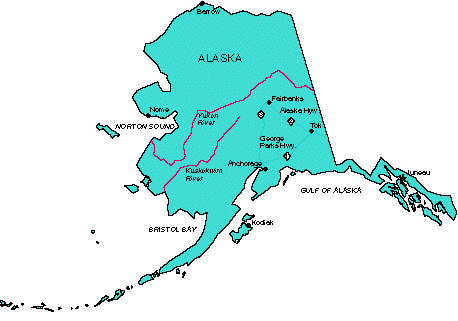 In
July of 1997, we spent two weeks on an Alaskan vacation. Now, two weeks
in any place certainly does not make one an expert on that area, but
at least we can share our thoughts and our impressions of this "49th"
state of the United States.
In
July of 1997, we spent two weeks on an Alaskan vacation. Now, two weeks
in any place certainly does not make one an expert on that area, but
at least we can share our thoughts and our impressions of this "49th"
state of the United States.
The first week was spent mostly on the water, as we sailed from Seattle,
on the small cruise ship, "The Spirit of Endeavor". In about
a day and a half we were on the "Inner Passage" of Southeast
Alaska. This was truly a beautiful and breathtaking adventure. As we
sailed north, the land grew more and more rugged. Eventually all roads
end and sea and air become the only way to access the area.
Forests of evergreen abound and yet we could see large areas of "clear
cut" logging which caused our guide, Monique, to speak of the great
debate between those who favor this method of logging and those who
do not. The large "scars" do indeed look terrible, but to
their credit at least, the logging companies do replant and the area
does renew itself, though it takes many years. The balancing of the
demands of society, the need for jobs, and our natural environment is
not easily accomplished, but it is bothersome how quickly economics
seems to win the day over environmental issues.
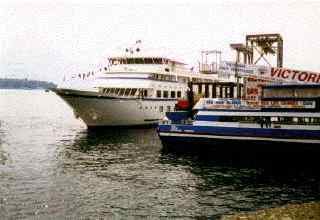 Being on a small cruise ship meant that we could easily come close to shore,
and later to the great glaciers. We had some wonderful views of bear,
moose, deer, and the like on the shore, and of course "killer"
and humpback whales, plus lots of family groups of dolphins, in the
water. At one point, Dave saw a humpback, the size of a Greyhound bus,
come straight out of the water, do a pirouette in the air, and hit the
water again with a sounding splash. That was a powerful and awesome
sight to see!
Being on a small cruise ship meant that we could easily come close to shore,
and later to the great glaciers. We had some wonderful views of bear,
moose, deer, and the like on the shore, and of course "killer"
and humpback whales, plus lots of family groups of dolphins, in the
water. At one point, Dave saw a humpback, the size of a Greyhound bus,
come straight out of the water, do a pirouette in the air, and hit the
water again with a sounding splash. That was a powerful and awesome
sight to see!
We made three stops on the cruise: at Ketchikan, Petersburg, and Sitka.
In each case, we took several hours to tour and take in the local color.
Fishing, and fish processing, of course, abound, with salmon, of course,
being the big industry. Ketchikan calls itself the "salmon capital
of the world", although the fishing industry seems even larger
at Petersburg. That is where we toured a cannery to see salmon, shrimp,
and many other kinds of fish being processed. Ketchikan was originally
a Tlingit (Native American) village, but Petersburg was settled by Norwegians,
and it indeed reminds one of a Norwegian fishing village.
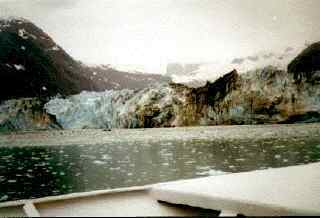 Our third stop was at Sitka, of Russan background. Of interest there is
the Russian Orthodox cathedral, left over from the early days, with
its priceless and beautiful icons. We also visited a raptor center,
and saw a bald eagle up close, and heard about their work at rescuing
these and other birds from serious injuries, with the goal being to
release them back to the wilds.
Our third stop was at Sitka, of Russan background. Of interest there is
the Russian Orthodox cathedral, left over from the early days, with
its priceless and beautiful icons. We also visited a raptor center,
and saw a bald eagle up close, and heard about their work at rescuing
these and other birds from serious injuries, with the goal being to
release them back to the wilds.
Alaska truly teems with bald eagles. There are more of them in this
one state than in all of the other states put together. They fly around
and nest in the trees everywhere. Quite a sight! They seem to be in
a state of recovery from being an endangered species, which is good
to hear! There is also a wonderful museum in Sitka, which enabled us
to learn a great deal about the background and settlement of this area,
and all of Southeast Alaska. This particular area of land is quite different
from the main body of the state in that it is quite a bit warmer, partaking
of the benefits of the "Japanese current". Its weather is
not really that much different from Iowa, from where we "hail".
This climate promotes also a lot of rainfall, and the forests and flowers
are beautiful, as is typical of any "rainforest".
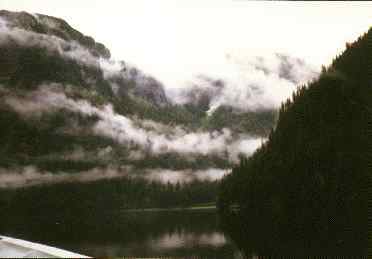 At the museum complex in Sitka, we stopped in a building where
totem poles were being carved. They begin with huge logs, and spend
days carving. You can buy the finished creation, but be ready for a
huge price as well, beginning at $500 and up. We're not sure how many
totem pole craftspersons there are left, but someone did mention that
the day may come when this is a lost art!
At the museum complex in Sitka, we stopped in a building where
totem poles were being carved. They begin with huge logs, and spend
days carving. You can buy the finished creation, but be ready for a
huge price as well, beginning at $500 and up. We're not sure how many
totem pole craftspersons there are left, but someone did mention that
the day may come when this is a lost art!
The moment we had been waiting for was the trip up John Hopkins Inlet
in Glacier Bay National Park, to view, up close, the John Hopkins Glacier.
One has to see this to really appreciate it. The mighty roar as huge
pieces break off of the front of the mile-wide glacier; the many pieces
of ice hitting the front of the boat (why did the Titanic come to mind??);
the hundreds of harbor seals laying on the many ice floes, having recently
calved; the cold wind blowing off the glacier; as we stood there in
the wind and rain taking our pictures and gazing in awe at the sight,
we thought "this is really Alaska--this is what we came for!"
This was truly the highlight of the trip, although it was marred some
by Monique telling is about the fact that the glaciers are retreating,
probably because of global warming. One wonders how much longer these
treasures will be available to us!
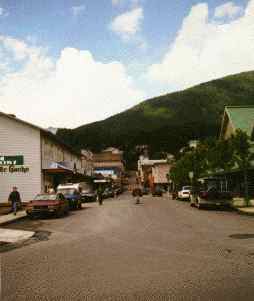 |
| Ketchikan |
Our sea adventure ended at Juneau, the capital of Alaska. Anchorage
has been in competition with Juneau for this honor, but so far, no change
has taken place. One would think that Anchorage would be a more logical
choice with its more central location, but we shall see! There is lots
of traffic in Juneau, and even an interstate highway. However, once
one gets outside of town, the interstate only goes a few miles--and
ends when it gets to the mountains.
We left Juneau by air, traveling to Anchorage, where we spent two nights,
beginning our week-long land tour. We saw few evidences of the earthquake
of over thirty years ago--the land heals itself rather quickly. Anchorage
is really becoming a modern "big" city, although it is somewhat
quieter than Seattle, or Chicago, or L.A., to be sure.
Anchorage has a beautiful historical museum, where one can learn a
lot about its history, especially the gold rush days. Those days have
a rather sour tone to them, based as they were on greed, but they are
still part of what makes Alaska what it is.
We took a side trip down Prince William Sound to a ski resort, and
saw much beautiful scenery along the way. We were not far from the oil
spill area, but that part of the state was not on our itinerary.
We left Anchorage by bus and traveled to Danali Park, which was a real
highlight. It would have been better if we could have seen Mt. McKinley,
but unfortunately we never did see it from the ground because of rain,
clouds, and fog (we did manage to see it from air a few days later but
that was all!) The time in Danali (which means "the great one"--i.e.,
the mountain) was spent in a long bus tour to the end of the one road.
No traffic is allowed on that road, save the buses that take large groups
in. The scenery is breathtaking, as is the wildlife. We were especially
thrilled as a large sow grizzly bear and her three cubs came right up
to the bus and spent some time just being "natural"--they
paid little or no attention to the commotion of camera and video camera
taking their pictures from the open bus windows. Two of the large, three-year-old
cubs even got in a "scuffle" right outside the window! It
was great!
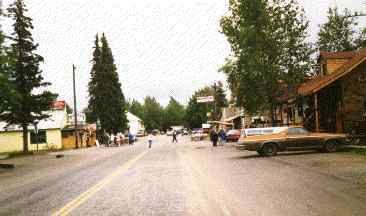 |
| The town of Talkeetna |
From Danali we rode by domed train to Fairbanks. Fairbanks is a far different
town from Anchorage, and disappointed us somewhat. There were some parts
that were pretty run down. We took a riverboat cruise and saw some interesting
Athabascan Indian historical things, but otherwise the tour was a very
commercialized one, and we were somewhat turned off by that. We did get
to see Susan Butcher, who has won the "Iditerod" several times.
The museum at the University at Fairbanks was a very interesting place,
featuring a lot of the wildlife and geologic history of the area, with
special emphasis on the aurora borealis.
During July it never gets dark at night in Fairbanks. The sun is down
from about 11 until 2 a.m. and in between it's twilight, which was a
little disconcerting. I would really dislike the many hours of darkness
during the winter--as well as the cold. We heard that it was down to
60 to 70 below this year (Fahrenheit)!
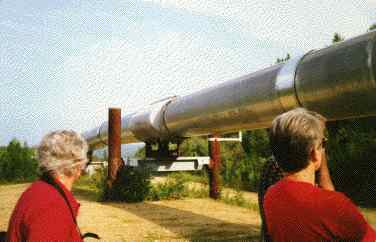 One of the stops in the Fairbanks area was at a section
of the Alaskan pipeline. Actually not a lot of the pipeline is above
ground--only in the areas where there is permafrost, and the pipe might
be heaved up due to that. The pipeline is heavily insulated, of course,
and has computerized "pigs" running through it to keep it
clean. Oil of course is the moneymaker in Alaska--in fact, it earns
enough for the state that there is no need for state income taxes or
property taxes. As a matter of fact, every citizen of the state receives
a $1000 rebate each year! The only way that one can lose these "gifts"
is to deface the pipeline in some way. As you might guess, the pipeline
is in "perfect" repair!
One of the stops in the Fairbanks area was at a section
of the Alaskan pipeline. Actually not a lot of the pipeline is above
ground--only in the areas where there is permafrost, and the pipe might
be heaved up due to that. The pipeline is heavily insulated, of course,
and has computerized "pigs" running through it to keep it
clean. Oil of course is the moneymaker in Alaska--in fact, it earns
enough for the state that there is no need for state income taxes or
property taxes. As a matter of fact, every citizen of the state receives
a $1000 rebate each year! The only way that one can lose these "gifts"
is to deface the pipeline in some way. As you might guess, the pipeline
is in "perfect" repair!
Editor's note: a reader from Alaska writes that property taxes do exist there, and can be fairly steep. Additionally, the amount of money Alaska citizens receive (as a taxable dividend, rather than a rebate) varies according to the current value of the Permanent Fund. Also, he writes that defacing the pipeline has nothing to do with Permanent Fund dividends. Living outside of Alaska for more than a certain number of days per year, however, will disqualify one from receiving the dividend.
After two nights in Fairbanks, it was time to fly back to Seattle and
end this fabulous tour. Alaska truly has many faces, but what stands
out for us are the wildlife, the fantastic scenery, the power of the
glaciers, the beauty of the rainforest, and of the sea. We would advise
this trip for any and all--it is truly worth your while!

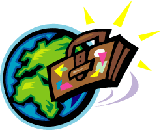


One of the stops in the Fairbanks area was at a section
of the Alaskan pipeline. Actually not a lot of the pipeline is above
ground--only in the areas where there is permafrost, and the pipe might
be heaved up due to that. The pipeline is heavily insulated, of course,
and has computerized "pigs" running through it to keep it
clean. Oil of course is the moneymaker in Alaska--in fact, it earns
enough for the state that there is no need for state income taxes or
property taxes. As a matter of fact, every citizen of the state receives
a $1000 rebate each year! The only way that one can lose these "gifts"
is to deface the pipeline in some way. As you might guess, the pipeline
is in "perfect" repair!
 This page last updated
February 14, 2008
. E-mail Tim
This page last updated
February 14, 2008
. E-mail Tim